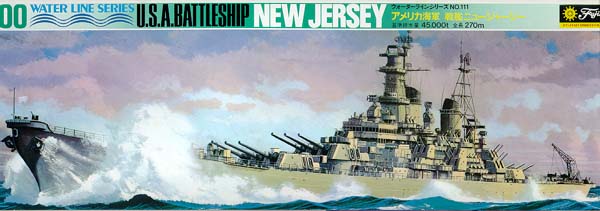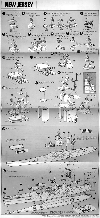
WW2 Iowa Class Battleship
Reviewed by Timothy Dike

| The largest US Battleships completed were the Iowa class. Weighing in at 45,000 tons these fast battleships combined the best that the previous North Carolina and South Dakota classes has to offer. While they were not as large as the Japanese Yamato class, or packed as large a main gun, the Iowa Class was more than a match for any other battleships. The era of the battleship effectively ended on December 7th 1941. But these battleships soldiered on into the 90's before being retired. | |||||||||||||||||||||
Statistics:
|
|||||||||||||||||||||
| This kit has been around for quite some time but still offers a lot of potential for the 1/700 waterline modeler. The hull is fairly accurate and with a little work on upgrading the secondary weapons this ship can be built into a nice representation of the New Jersey. The hull is molded in the typical water style, with a separate bow insert. The stern is a little too blunt but probably not worth the trouble to try to fix. The splinter shields are a little too thick for my taste and I don't care for the molded on stairs and rafts, but they are passable if you don't want to resort to sanding them all away and replacing them. The model has a noticeable "armor belt" and portholes in the hull, while the real thing had no portholes, and the main armor belt is internal. You need to sand the raised area smooth to the rest of the hull and fill in any hull portholes. |
to enlarge |
||||||||||||||||||||
| The superstructure parts are a little lacking in detail and the splinter shield are a little short, but they are passable. You will probably want to drill out the funnel caps and rework some of those superstructure parts. | |||||||||||||||||||||
| There is a separate sprue with the New Jersey's distinctive main mast and platforms. | |||||||||||||||||||||
| The armament varies from pretty good to poor. The main guns are the best parts of the bunch. The twin 5" 38 turrets are usable but are best replaced with those in the Skywave E-9 weapons set or the Loose Cannon 5" 38 cal set. The 40 mm and 20 mm are also in need of replacement. I would also replace the gun directors. | |||||||||||||||||||||
| The kit also includes the flat waterline bottom and a weight. The only decals are a US flag printed on paper that you will have to cut out, fold together, and glue. | |||||||||||||||||||||
| The instructions consist of several exploded views that clearly show
parts placement. History, specifications and painting instructions are
on the other side. The painting guide calls out colors for 1951, so you
will have to consult your references for the appropriate colors.
Conclusions: This is one of the kits that first attracted me to 1/700 scale and while it was quite an impressive kit in it's day. It is in need of upgrading to bring it up to today's standards. There are a number of Photo Etch sets made that will really improve this kit as well. Until we see a good WW2 Iowa class kit in resin, this kit is a good inexpensive alternative. |
 |
||||||||||||||||||||
|
|
|||||||||||||||||||||